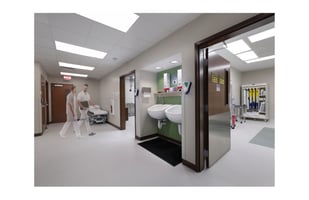In the world of healthcare, efficiency is often seen as a virtue. This is especially true in...
Outpatient Endoscopic Spine Surgery and ASC Design
Endoscopic spine surgery in the outpatient setting is transforming the field of spinal surgery, providing patients with a viable alternative to traditional open surgery that is both minimally invasive and highly effective. This state-of-the-art technique enables surgeons to access and treat spinal conditions through small incisions, resulting in reduced post-operative pain, faster recovery times, and shorter facility stays.
In ambulatory surgery centers, patients have the opportunity to undergo endoscopic spine surgery and return home on the same day, eliminating the need for overnight hospital stays. This not only offers convenience but also reduces the risk of acquiring infections associated with hospitals, as patients can recover in the comfort of their own homes. Additionally, this approach brings significant cost savings by avoiding the extended stays typically required for traditional open spine surgery, while also benefiting from the lower overhead costs of ambulatory healthcare facilities.
The advent of endoscopic spine surgery in the outpatient setting is greatly supported by advanced imaging technology. Surgeons can utilize real-time imaging, such as fluoroscopy using a C-arm or biplane, to precisely guide their instruments and visualize the affected area without the need for extensive disruption of surrounding tissues. This targeted approach minimizes damage to nearby structures and enables a more precise and accurate surgical intervention.
To optimize the success of endoscopic spine surgery in the outpatient setting, it is important to have spacious operating rooms that can easily accommodate the necessary equipment and personnel. Larger operating rooms provide the flexibility needed to aid in a smooth surgical process. However, it is also important to consider "right-sizing" the ORs when planning the facility, as space is often at a premium and building more space is expensive. Providing storage for supplies and equipment that is easily accessed from the OR is essential. Examples include direct access to sterile storage from the OR, parking in the semi-restricted corridor, and nearby equipment storage. In addition, IT and AV requirements must be properly integrated to support advanced imaging and navigation technologies. Carefully coordinating the location of video monitors, whether on carts, booms, or other mounts, for real-time visualization during the surgery, is also very important.
While spine surgery may be performed with a mobile c-arm, operating rooms for spine surgery may incorporate fixed imaging equipment such as a c-arm or biplane. In these cases, the c-arm, or dual c-arm in the case of a biplane, and the operating table will be attached to the structure. Extra space above the ceiling and additional structural supports will be required. Meticulous coordination of the ceiling layout, lights, HVAC diffusers, and other elements is necessary to work around the rails that support the c-arm, shielding, monitor, and boom light, among other things. Trenching of the floor slab for conduits and thickened slab areas or additional footings will likely be necessary. A control room adjacent to the OR, for a technician to operate the equipment, and a room to house the imaging equipment are required. The OR must have lead shielding and the large window from the control room into the OR will need leaded glass. While there are numerous other requirements, we will stop there to keep the post at a reasonable size.
Endoscopic spine surgery in the ambulatory setting represents a paradigm shift in the field of spinal surgery. With its minimal invasiveness, utilization of advanced imaging technology, faster recovery times, and cost-effectiveness, it offers patients a superior alternative to traditional open surgeries. As this innovative technique continues to evolve, and as new advances in spine surgery are introduced, surgery center design must respond to assure the procedures will be performed safely and effectively for years to come.
Visit our ambulatory surgery center page at the following link where you can find examples of ASC's that include spine surgery: https://www.hsarchitecture.com/work-ambulatory.




